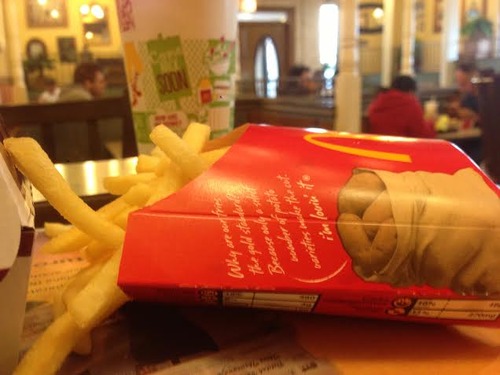
In 1983, David Bermant, the owner of the Cermak Shopping Plaza in Berwyn, IL, challenged the McDonald’s Corporation to do something different with a new restaurant it was planning to build on his property. Reluctantly, McDonald’s agreed, and chose James Wines’ design, one that looked mostly like every other McDonald’s restaurant, but would appear to float a few feet above the ground.
One of the comforts of McDonald’s is that they are all the same; eating in one is something I look forward to on road trips. I usually order the #2 meal, medium—two cheeseburgers, French fries, Diet Coke. Sometimes I order the #5, sometimes the #7.
I visit Cermak Plaza to take photographs. It’s raining and I drive aimlessly around the parking lot, irrationally afraid that if I stop and start taking pictures, I’ll get arrested. I notice the poor design of the parking lot, how it’s difficult to make a loop without violating the yellow lines of the parking spaces or exiting onto congested Cermak or Harlem. The entrance to the Office Depot is especially tricky, with an awkward convergence of traffic and Stop signs in the wrong places. I’m confused because I can’t find any of the art—I’d read the shopping plaza contains thirty examples of kinetic art, including the famous Spindle, and the Floating McDonald’s, but I can’t find any of them. I wonder if I’m in the wrong place, but verify, with my phone, that I’m where I should be. I take a few photos, anyway. I pull my car up to an enormous snow pile, black with soot, an upside down shopping cart on top, like a crown. I take a few more pictures of this and try to think of it as somebody’s homage to the sculptures that used to be displayed here. When I leave, I still think I’m missing something, as if I haven’t looked enough. On the way home, I run out of gas.
Some of the art formerly on display in the plaza: Bee Tree, by George Rhoads. Byzantine Solution by Mattie Berhang. Kettle Head Choir by Steve Gerberich. Moon Bells by Barry Miller. Pinto Pelt (just what it sounds like) by Dustin Shuler. Spindle, also by Dustin Shuler. Windamajig by George Rhoads. Some of the current stores open at the plaza: K&G Fashion Superstore, Marshall’s, LensCrafters, Rainbow, Meijer Marketplace, Walgreens, Office Depot. A hybrid shopping mall, an assemblage of parking, commercial space, artwork, signs, and lights meant, perhaps, to showcase a particular vision, but also, I think, to elevate the shopping experience. But how? Perhaps, instead of elevating shoppers,...
You have reached your article limit
Sign up for a digital subscription and continue reading all new issues, plus our entire archives, for just $1.50/month.
Already a subscriber? Sign in




